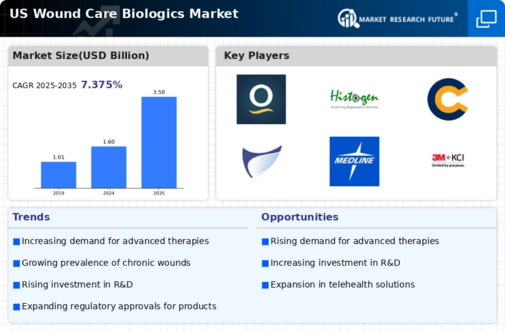Increased Healthcare Expenditure
The rising healthcare expenditure in the US is significantly impacting the wound care-biologics market. With healthcare spending projected to reach approximately $6 trillion by 2027, there is a growing focus on advanced treatment modalities. This financial commitment allows for the development and adoption of biologic products that offer superior healing properties compared to traditional methods. As hospitals and clinics allocate more resources towards innovative wound care solutions, the market is expected to witness robust growth. Furthermore, the emphasis on value-based care encourages the use of effective biologics that can reduce hospital stays and improve patient recovery times, thereby aligning with the broader goals of the healthcare system.
Supportive Regulatory Environment
A supportive regulatory environment is fostering growth in the wound care-biologics market. Regulatory agencies in the US are increasingly streamlining the approval processes for biologic products, encouraging innovation and expediting access to new therapies. This regulatory support is crucial for manufacturers, as it reduces the time and costs associated with bringing new products to market. Additionally, the establishment of clear guidelines for the development and evaluation of biologics enhances confidence among stakeholders. As a result, companies are more likely to invest in research and development, leading to a wider array of effective wound care solutions that meet the needs of patients and healthcare providers.
Rising Incidence of Chronic Wounds
The increasing prevalence of chronic wounds, such as diabetic ulcers and pressure sores, is a primary driver for the wound care-biologics market. In the US, it is estimated that around 6.5 million patients suffer from chronic wounds, leading to a substantial demand for advanced treatment options. The aging population, coupled with the rise in diabetes and obesity rates, contributes to this growing incidence. As healthcare providers seek effective solutions, the The market is likely to expand, with innovative products designed to promote healing and reduce complications. This trend indicates a shift towards biologic therapies that can address the complex nature of chronic wounds, thereby enhancing patient outcomes and reducing healthcare costs.
Technological Innovations in Biologics
Technological innovations play a crucial role in shaping the wound care-biologics market. Advances in biotechnology and materials science have led to the development of novel biologic products that enhance wound healing. For instance, the introduction of bioengineered skin substitutes and growth factor therapies has revolutionized treatment approaches. These innovations not only improve healing rates but also reduce the risk of complications associated with traditional wound care methods. As research and development continue to progress, the market is likely to see a surge in new product launches, further driving competition and expanding treatment options for healthcare providers.
Growing Awareness of Advanced Wound Care
There is a notable increase in awareness regarding advanced wound care solutions among healthcare professionals and patients alike. Educational initiatives and training programs are being implemented to inform stakeholders about the benefits of biologic therapies in the wound care-biologics market. This heightened awareness is likely to drive demand for advanced products, as clinicians recognize the efficacy of biologics in promoting faster healing and reducing infection rates. Additionally, patients are becoming more informed about their treatment options, leading to a preference for advanced therapies. As a result, the market is poised for growth, with an increasing number of healthcare facilities adopting biologic products as standard practice.























Leave a Comment